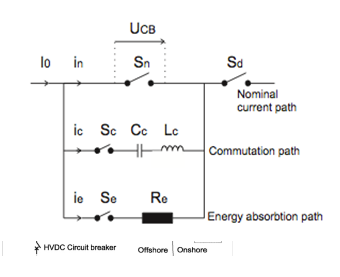HVDC Circuit Breakers
Home | About | Technologies | Report Download | Contact Us
Technologies > Electromechanical Circuit Breakers
On the figure we can see a basic electromechanical circuit breaker. The
breaker consists of three parts:
·
The
nominal current path is where DC current passes through and the
switch is closed during normal operation
·
The commutation path
consists of a switch and a resonant circuit with an inductor and a capacitor and
is used to create the inverse current
· The energy absorption path consists of a switch and a varistor

Figure 2: Electromechanical Circuit Breaker [1]
The commutation path has a series resonance. When interruption is required,
current oscillation can occur between the nominal and the commutation path at the
natural frequency (1/LC). If the amplitude of the oscillating current is larger
than that of the input current then zero crossing occurs and the switch can interrupt
the current in the nominal path. Current (Io) will continue to flow and will charge
the capacitor. If the capacitor voltage exceeds a given value, which is chosen to
be the voltage capability of the circuit breaker, the energy absorption path will
act causing the current to decrease.
This is a basic circuit that would need further implementations to be
efficient in high voltages. Reduction in cost and better use of the costly components
(varistor, capacitor) will be required. Also, the optimum capacitance value would
minimize the breaker's interruption time and improve the whole interruption performance.
Furthermore, current oscillations grow when the arc resistance (dU/dt) of the switch
on the nominal path is negative. Growing oscillations can lead to faster current
interruption. At the same time a large C/L ratio can help maximize the breaker's
interruption performance.